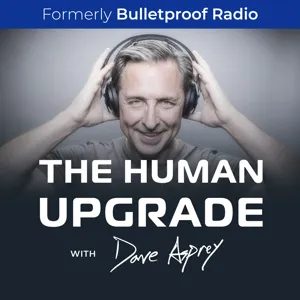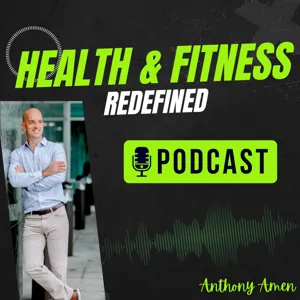Podcast Summary
Understanding the Importance of DEXA Scans and Protein: DEXA scans provide essential data on bone density, body fat percentage, lean tissue mass, and bone size. Protein intake should be tailored to individual needs, with considerations for timing and division throughout the day. Time-restricted feeding impacts circadian rhythm and brain health.
The hosts, Peter Atia and Nick Stenson, discuss how a DEXA scan reveals four key pieces of information: bone density, body fat percentage, lean tissue mass, and bone size. They then delve into the topic of protein and answer several questions regarding how much protein is needed, when it should be consumed, and how it should be divided throughout the day. Additionally, they revisit the topic of time-restricted feeding, sharing their evolving views and providing new insights on the relationship between food, circadian rhythm, and brain health. Overall, this episode offers valuable information for anyone interested in optimizing their body composition and understanding the importance of proper interpretation of health data.
Focus on hip and spine BMD measurements in DEXA scan results: DEXA scans are crucial for assessing bone health, focusing on hip and spine BMD, providing minimal radiation exposure, and outweighing benefits.
When interpreting DEXA scan results, it's important to focus on bone mineral density (BMD) measurements, specifically at the hip and spine, as they are the most reliable indicators of overall bone health. Other metrics, such as body composition analysis, may not be as significant. A DEXA scan uses a low-dose X-ray to measure bone density, and while radiation exposure should be considered, the amount received during a DEXA scan is relatively low and generally safe. The NRC recommends limiting annual radiation exposure to 50 millisieverts, and a DEXA scan typically provides less than 10 millisieverts of radiation. Therefore, the benefits of understanding your bone health through a DEXA scan outweigh the minimal radiation exposure. In the upcoming discussion, we will explore real-life patient case studies and delve deeper into protein consumption and time-restricted feeding in relation to bone health.
DEXA scans: Safe and Effective Body Composition Measurement: DEXA scans are safe, delivering minimal radiation and distinguishing between bone, fat, and other tissues for valuable body composition information.
DEXA scans, which are used to measure body composition and diagnose conditions like osteoporosis, are incredibly safe and low-risk. They expose individuals to less radiation than common everyday activities, such as a cross-country flight or even a mammogram. A DEXA scan typically delivers less than 20 micro-severts of radiation, making it an insignificant amount compared to other medical procedures. The scan distinguishes between bone, fat, and other tissues, providing valuable information about body composition. Most people focus on their body fat percentage, which is calculated by dividing the total fat mass by the total mass of the individual. DEXA scans should be conducted once or twice a year, and the benefits far outweigh the minimal radiation exposure.
A DEXA scan provides more than just body fat measurements: A DEXA scan offers insights into bone mineral density, visceral adipose tissue, appendicular lean mass index, and fat-free mass index, helping assess health status and risks.
A DEXA scan provides valuable health information beyond just measuring body fat. While body fat is a consideration, the scan also assesses bone mineral density (BMD), visceral adipose tissue (VAT), appendicular lean mass index (ALMI), and fat-free mass index (FFMI). These measurements help determine an individual's health status and risk factors. BMD is essential for diagnosing osteopenia or osteoporosis, and VAT is crucial for understanding visceral fat, which poses greater health risks than subcutaneous fat. ALMI and FFMI are essential for evaluating muscle mass in the extremities. Not all DEXA scans provide these detailed metrics, so it's essential to know what data to expect from your scan. A key limitation is that some scans only provide a total body Z-score for bone mineral density, which may not be sufficient for a complete assessment.
Understanding Health Metrics Beyond BMI: Explore lesser-known health metrics like VAT, AL, MI, and FFMI for a more comprehensive understanding of health and wellness.
When it comes to understanding Body Mass Index (BMD) and related health metrics, it's essential to seek out detailed and segmented information from specialized sources. While BMD is a well-known metric, other metrics like Visceral Adipose Tissue (VAT), Android-to-Gynoid Ratio (AL), Muscle Mass Index (MI), and Fat Free Mass Index (FFMI) might be less familiar to those outside the health and fitness industry. To gain a better understanding of these metrics and their importance, consider listening to past AMA episodes or becoming a member for exclusive and in-depth content. Membership benefits include access to full AMA episodes, comprehensive podcast show notes, and short podcast clips highlighting key topics. By staying informed about these metrics, you can make more informed decisions regarding your health and wellness journey.
Prioritize health and transparency: Individuals should prioritize their health by seeking medical advice promptly and being transparent about potential conflicts of interest for informed decision-making.
Individuals should prioritize their health and not delay seeking medical advice for any condition they may have. It's essential to consult healthcare professionals for proper diagnosis and treatment. Additionally, transparency is crucial, especially when it comes to potential conflicts of interest. I, Peter A. Diamandis, take conflicts of interest seriously and disclose all companies I invest in or advise on my website, peteratiamd.com/about, for full transparency. This openness helps maintain trust and ensures that all parties involved are aware of potential conflicts. Overall, prioritizing health and transparency are key to making informed decisions.






